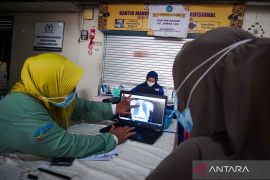Over the past four years, the government has channeled Rp187 trillion for village funds, and the absorption has also continued to increase support for the quality of life in rural communities.
In supporting the quality of life in the community, village funds have been used to build, among others things, 18,477 Integrated Health care Center (Posyandu) units, 178,034 units for Bathing, Washing, and Latrine (MCK) facilities, 48,694 Early Childhood Education Buildings, 3,026 embankments, and 37,662 wells.
Villages, Disadvantaged Regions and Transmigration Minister Eko Putro Sandjojo has stated that in supporting the economic activities of the community, village funds have also been used to build many village roads, bridges, 4,711 boat moorings, 14,770 Village-owned Enterprises (BUMDes), 6,932 village markets, 179,625 land retention areas, 942,927 clean water facilities, and 39,351 irrigation channels.
The minister explained that village funds have also increased per capita income per month in rural areas from Rp. 572,586 in 2014 to Rp804,011 in 2018, and villagers` incomes also increased by 6.13 percent per year during the 2015-2017 period.
With economic growth continuing to improve due to village funds, villages became more prosperous following the decline in the number of disadvantaged villages, declining inflation in the countryside, a reduction in the poverty rate to 7.02 percent in 2018, and a fall in the open unemployment rate to 3.72 percent, from 4.01 percent.
Starting from 2019, President Joko Widodo (Jokowi) has promised to provide funds for village operations, amounting to some five percent of village funds.
When opening the national work meeting on appropriate technology in Bandung, West Java, recently, President Jokowi remarked that there would be village operational funds, and village heads should use the funds to maximize benefits to the communities.
The current government is drafting a Revised Government Regulation (PP) Number 22 Year 2015 on Village Funds, to include budgetary elements for village operational funds.
In addition to promising village operational funds, the President also said the government would allocate budgets to urban village offices.
Additionally, the president instructed all village heads to utilize the village funds to reach targets, especially after the value was increased for 2019.
The president urged the village heads and officials to synergize development in rural areas with infrastructure development conducted by the central government.
"Next year, the village budget will be approximately Rp73 trillion. The funds are greater, but the use must be right on target. This is not a matter of spending money, but being on target, effective, and useful," the president said, adding that in the past four years, the government had conducted massive infrastructure development, starting from toll roads, terminals, ports, airports, extensions of runways and building dams.
However, infrastructure development by the central government has not been balanced in line with the development of public facilities and facilities in the countryside. Hence, the president has appealed to the village heads, village officials, and local governments to optimize development using village funds.
The state budget for infrastructure development in 2018 reached at least Rp400 trillion; rising rapidly from the Rp150 trillion figure in 2014.
Along with the increase in infrastructure development spending, the budget for village funds has also increased since it was first launched in 2015, amounting to Rp20 trillion, Rp60 trillion in 2018, and Rp73 trillion in 2019.
In its implementation since 2017, village funds have contributed significantly to welfare improvement, although certain parties still use it for their own benefit.
According to the minister of Villages, Disadvantaged Regions and Transmigration, village funds can also be used to help accelerate the alleviation of poverty as the main cause of stunting the growth of children.
The minister said the purpose of village funds is to reduce poverty, repair infrastructure in the villages, and empower village economies.
Villages, Disadvantaged Regions and Transmigration Ministry Secretary General Anwar Sanusi has said the decline in poverty rates in the country was attributable to village funds that have boosted rural economic growth and community development.
The village funds, according to him, have provided added value for rural communities in coping with various problems, such as poverty and unemployment.
Based on data at the Central Bureau of Statistics (BPS), the poverty rate has dropped to less than 10 percent, the lowest ever in the country, and the sharpest decline was recorded in rural areas.
Hence, Sanusi has said he was convinced credit should be given to village funds for the decline in poverty in rural areas.
In addition, this year, village funds are required to be used for labor intensive projects, and 30 percent of the money is set aside to pay workers. The funds, therefore, are used only for productive programs and to help reduce unemployment.
The government plans to increase the budget for village funds, as the program is considered successful in reducing poverty.
According to the minister of Villages, Disadvantaged Regions and Transmigration, the first cause of stunted growth in children is poverty, the second cause is lack of knowledge, and the third is the absence of basic infrastructure.
The minister remarked that there is no basic infrastructure, such as clean water facilities, electricity, and sanitation facilities, in many villages, which contribute to stunting in children.
But he lauded the efforts of the World Bank, which was serious in addressing the issues of stunted growth in children.
EDITED BY INE
Reporter: Otniel Tamindael
Editor: Otniel Tamindael
Copyright © ANTARA 2018












